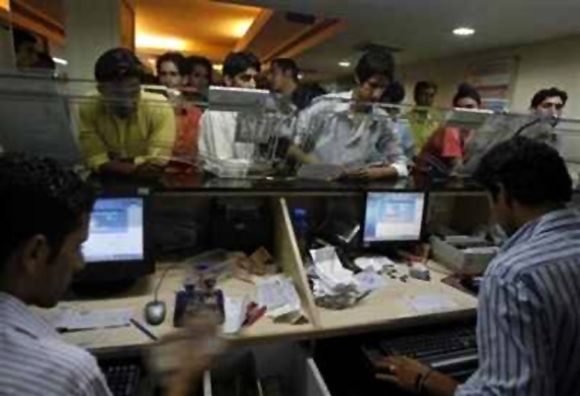 | « Back to article | Print this article |
 The poor and unbanked can take their rightful place as consumers of financial services only if the Modi government encourages different entities to advance the financial inclusion agenda, say Vikram Gandhi & Chandni Ohri.
The poor and unbanked can take their rightful place as consumers of financial services only if the Modi government encourages different entities to advance the financial inclusion agenda, say Vikram Gandhi & Chandni Ohri.
One hundred and fifty million new bank accounts within a year, 60,000 new business correspondents, a new credit guarantee fund, an overdraft facility for households completing a financial literacy programme - these are part of the new government's Sampoorn Vittiya Samaveshan Mission (Full Financial Inclusion Mission) that Prime Minister Narendra Modi announced on August 15.
All the important checkboxes appear to have been ticked as far as access to financial services goes. But financial inclusion experts are not cheering yet since realising this vision requires significant shifts in the regulatory ecosystem.
To provide more context: as opposed to the goal of opening 150 million accounts in one year, all public and private sector banks collectively opened 108.5 million accounts in the last three years.
Despite the efforts of the government and the Reserve Bank of India (RBI) over the past few decades, India's current state of financial inclusion is quite dismal, with approximately half the population outside the ambit of formal banking (a World Bank estimate is even lower showing that only 35.2 per cent adults have an account with a formal financial inclusion.)
To accomplish the mission of full financial inclusion two major areas need a rethink.
First, policymakers have positioned financial inclusion as an obligation rather than an opportunity. Various efforts over the years, especially annual financial inclusion targets on which banks are obliged to deliver, have created a mindset that the poor are unbankable.
What is required instead is an innovation mindset to overcome the real operational challenges of serving a large populace with small transaction amounts in areas where infrastructure and technology are rudimentary at best.
Such a mindset can be triggered if the unbanked are positioned as an untapped market segment. However, given that banks usually approach these mandates with little enthusiasm, they are loathe to invest more resources and energy into innovating for a population that they don't see as a viable target segment.
So others have stepped in - microfinance institutions (MFIs) in particular - and developed low-cost, technology-driven and scalable models to deliver credit to the poor - seeing an opportunity that others didn't. MFIs are now serving more than 30 million clients with average annual growth rates of approximately 25 per cent.
So, the first change that needs to be made is to position the unbanked and the poor as a (mostly) untapped opportunity, with the regulations acting as an enabler for innovations that are necessary to serve this population.
At the very least, policymakers and regulators should stay away from dictating the specifics of products (such as loan sizes and terms or features of a savings bank product), the specific technology to be used or the methods for verifying client identity. At the other end, there needs to be some flexibility around which geographies the financial service providers should work in and the service charges they can impose.
Second, the financial inclusion goal is mainly seen as the right and responsibility of the banks. Over the years, regulators have encouraged the setting up of various banks (regional rural banks and local area banks are just a few examples) and, more recently, banking agents (business correspondents).
These initiatives have, at best, shown mixed results and certainly not scaled up to the extent that is needed. This continued focus on banks (and bank-like entities) to fulfil the financial inclusion goals ignores the recent advances in technology and changes in social interactions.
All over the world, we see developing economies such as Brazil, Kenya, Paraguay and others experimenting and innovating with new models of financial inclusion, especially the use of mobile money.
Mobile money users now outnumber bank account holders in nine African markets. But we don't need to look that far.
Two of the fastest growing mobile money markets are just across the borders in Pakistan and Bangladesh, where innovative companies and enabling regulations have fuelled the rise of mobile money. bKash in Bangladesh has gained more than 11 million clients in two and a half years starting from scratch.
Given the scale of the unbanked population in India, it would behove policymakers to encourage different entities to advance the financial inclusion agenda. This is also important given India's diversity so that a single model cannot sustainably cater to different contexts effectively.
Recent policies from RBI on small banks and payments banks seem to indicate that the central bank is open to experimenting with different models - these are welcome steps. The new government seems to have a definite focus on financial inclusion. We hope it recognises that announcing yet another mandate without significant regulatory shifts and an enabling environment is only going to lead to the repetition of past mistakes.
The regulators' attention should be focused on a high-level enabling environment to harness and direct the inventiveness and capability of a wide range of players.
The poor and unbanked can then take their rightful place as consumers (not beneficiaries) of financial services.
Vikram Gandhi, former Vice-Chairman of Investment Banking at Credit Suisse NY, is on the Board of Grameen Foundation and Founder CEO of VSG Capital Advisors and the recently established Asha Impact. Chandni Ohri is CEO, Grameen Foundation India, a leading technical advisory firm in financial inclusion.